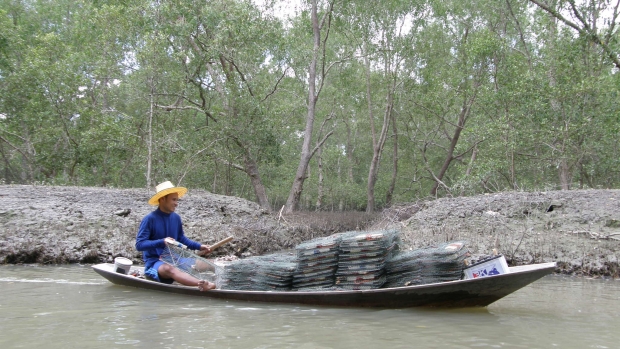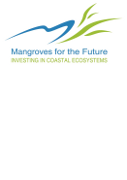Grants :: Small Grant Facilities :: Collective rehabilitation and conservation of mangroves at Ban Don Bay
Collective rehabilitation and conservation of mangroves at Ban Don Bay

Conserving mangroves in Ao Baan Don , Thailand © SSereepaowong , 2009
Objectives
This project aimed to rehabilitate and protect local coastal resources. It set a target of a 20% increase in mangrove cover in its focal area, to be achieved in an integrated manner at village, district and provincial levels.
Background
Ban Don Bay is an integrated marine and coastal ecosystem on the southern Gulf of Thailand, extending about 120 km. Once rated one of the most biodiverse areas in the Gulf of Thailand, with habitats such as mangroves, seagrass beds and coral reefs, it has now been badly degraded by aquaculture, destructive fishing, pollution, conflict among resource users and a lack of intersectoral cooperation. The bay was designated a Ramsar Wetland of International Importance in 2000.
The Ban Don Bay Conservation Network was established 30 years ago by local people who were experiencing the negative impacts of environmental degradation and wanted to take collective action to address it. The Network has financed its conservation activities mainly with donations from community members, and has also cooperated with NGOs and other development projects.
Target beneficiaries
About half of the 2,890 households in the project area, most of whom earn their living from small-scale fishing or depend on other coastal resources for their livelihoods.
Outputs
- Capacity built within the target population and networks established to monitor environmental conditions across the project area.
- Demarcation of a conservation area for protection and natural regeneration to prevent illegal fishing.
- Capacity built to conduct local resource inventories.
- Production and distribution of a set of educational reference materials about mangroves and threatened flora and fauna in Ban Don Bay.
Accomplishments and challenges
Members of community-based organisations and their leaders developed technical and managerial skills. A number of community members were elected as heads of sub-district administrative organizations. These organizations provided additional co-financing to support project activities.
Community organizations demarcated and managed a conservation zone in the sub-districts of Khao Than and Tha Chang.
Participating sub-district administrative organizations updated their data and other information on local socio-economic indicators for future reference and use by officials and households in the project area.
The project brought together several national partners and local government authorities to participate in strengthening conservation efforts, launched community-based research on coastal resource conservation and ecotourism, and promoted sustainable livelihood activities.
Challenges
Competition among community groups delayed funding and complicated financial arrangements. The project committee resolved this issue by setting up a strict auditing system.
Conflict between communities and private businesses in Khlong Chanark sub-district made demarcation of a conservation zone there difficult. The network coordinated with relevant government agencies, local administrative organizations and NGOs to resolve this conflict.
Contributions to cross-cutting themes
Communications
A media spot on the Ban Don Bay Network was featured by the local newspaper, radio station and television network. This focused on a community meeting with the governor of Surat Thani to express local people’s gratitude for a new patrol boat and sets of network surveillance equipment donated by the province.
A website, www.tnewsnetwork.com, featured a “Public Forum on Ban Don Bay Coastal Resources Management” on 28 July 2009. Another website, www.suratnews.com, featured visits to the project area by NGOs and a group of Japanese students on 1 September 2009.
Lessons Learned
With coastal and marine ecosystems better protected and more productive, members of the Network feel confident they can set up a rotating fund to finance livelihood activities and a savings group to assist members. The two funds will be managed by network members and are expected to be self-financing.
Currently the Network is reaching out to younger people to promote a more harmonious and collaborative, as opposed to adversarial, approach to conservation.
Project Facts
Country
Location
Ban Don Bay, Surat Thani, Thailand
Topic
- Sustainable Livelihoods
- Community Resilence
- Integrated Coastal Planning
- Knowledge management and communications
Duration
1st May 2009 to 30th Nov 2010
MFF Grant Amount
US$9,722
Co-financing Partner
Community-based organisations made cash and in-kind contributions worth US$1,200 and US$14,720 respectively. Local administrative organizations made in-kind contributions valued at US$300 in total. The Surat Thani Provincial Public Health Office contributed US$12,600 in cash, and the Office of the Governor of Surat Thani contributed a patrol boat and surveillance equipment worth US$16,667.
Implementing Partner
Ms Nipa Salpradi
Project Manager
Ban Don Bay Conservation Network
180/3 Moo 1, Pathumphorn Road,
Makhamtia, Muang,
Surat Thani 84000, Thailand
Tel: +66 89 4738933
Email: lek_nipas@hotmail.com
Related Publications

Collective Rehabilitation and Conservation of Mangrove in Ao(Gulf) Baan Don
Author: MFF Thailand
Posted on: 4th Dec 2013
Category:
Size: 4 KB
